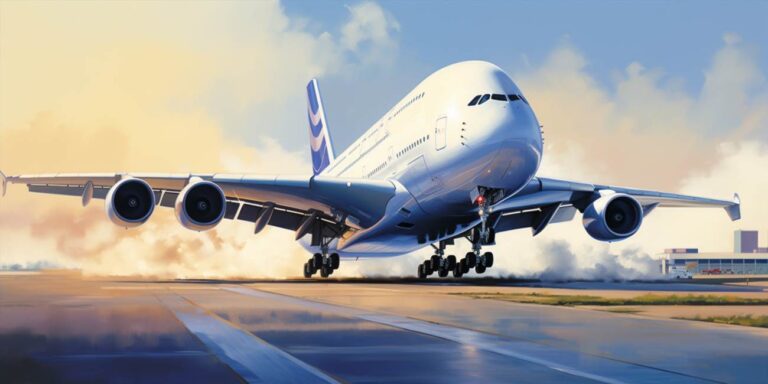One of the key factors distinguishing Airbus planes by size is their wingspan. The Airbus A380, often hailed as the giant of the skies, boasts a wingspan of 79.75 meters, making it the widest passenger aircraft ever built. This expansive wingspan not only contributes to its aerodynamic efficiency but also accommodates the mammoth capacity it holds within.
Speaking of capacity, the Airbus A380 takes center stage with its ability to carry an astounding number of passengers. In a typical three-class configuration, this behemoth can accommodate up to 853 passengers. This exemplifies the commitment of Airbus to redefine air travel by offering a harmonious blend of luxury and scale.
On the other end of the spectrum, when it comes to smaller yet highly efficient aircraft, the Airbus A320 family shines. The A320, A321, A319, and A318 collectively form a versatile family of single-aisle aircraft. These planes, tailored for shorter routes, are known for their flexibility and economic efficiency.
Let’s delve into the specifics of the Airbus A321, recognized for its extended fuselage compared to its siblings in the A320 family. With an overall length of 44.51 meters, the A321 strikes a balance between capacity and range. In a typical two-class configuration, it can accommodate around 240 passengers, making it an ideal choice for medium-haul flights.
Another notable mention is the Airbus A350, representing the next generation of long-range aircraft. The A350’s design incorporates advanced materials and aerodynamics, contributing to fuel efficiency and reduced environmental impact. With a length of 66.89 meters, the A350 XWB series offers a range of seating configurations, accommodating up to 440 passengers in a typical three-class layout.
Summing up the diverse array of Airbus planes by size, it’s evident that Airbus has successfully tailored its aircraft to meet the varied demands of the aviation industry. Whether soaring through the skies with the vast wingspan of the A380 or navigating shorter routes with the agile A320 family, Airbus continues to leave an indelible mark on the world of aviation.
The largest airbus a380 plane seating and interior
The Airbus A380 stands as a marvel in aviation, known for its colossal size and impressive seating capacity. The largest passenger airplane in the world, the Airbus A380 boasts an interior that redefines luxury and comfort for long-haul flights.
Let’s delve into the seating arrangement, where passengers can experience a journey like never before. The A380’s seating configuration varies among airlines, but a typical layout includes four classes: First Class, Business Class, Premium Economy, and Economy. Each class is meticulously designed to cater to the diverse needs and preferences of passengers.
In First Class, passengers are treated to the epitome of luxury. The spacious cabins feature private suites with fully-flat beds, ensuring a restful and exclusive travel experience. Fine dining options, personalized service, and amenities that cater to every whim make First Class on the A380 a truly opulent affair.
Business Class on the A380 offers a balance between comfort and functionality. Passengers enjoy lie-flat seats that provide ample space to work or relax. With dedicated cabins designed for privacy, business travelers can stay focused during the journey, ensuring they arrive at their destination refreshed and ready for their endeavors.
For those seeking a step above Economy but not quite First or Business Class, the Premium Economy option on the A380 is a perfect choice. Enhanced legroom, wider seats, and additional amenities contribute to a more comfortable journey.
Stepping into Economy Class, passengers still benefit from the A380’s spacious design. With a range of in-flight entertainment options, ergonomic seats, and thoughtful features, Economy Class passengers experience a pleasant and enjoyable flight.
Now, let’s highlight some of the key features that set the Airbus A380 apart. The aircraft is equipped with advanced technology to enhance safety, efficiency, and passenger experience. From noise-canceling technology to reduce cabin noise to state-of-the-art in-flight entertainment systems, every aspect is crafted with precision.
One notable aspect is the iconic upper deck, a signature feature of the A380. This area often houses premium cabins, providing passengers with a sense of exclusivity. The panoramic windows offer breathtaking views, adding to the overall appeal of the journey.
As we navigate through the details of the Airbus A380’s interior, it becomes evident that the aircraft is not merely a mode of transportation but a destination in itself. Whether you find yourself in the lavish First Class suites or the thoughtfully designed Economy cabins, the A380 promises an unforgettable flying experience.
The longest airbus a350 airplane fuel capacity and engines
The Airbus A350, renowned for its impressive capabilities, stands as a pinnacle of aviation engineering, specifically designed for twin-engine long-haul journeys with extra-long range. One of its remarkable features is the cavernous fuel capacity that propels it across vast distances without compromise.
At the heart of its endurance lies the fuel-efficient powerhouses. The engines of the A350 are a testament to modern propulsion technology, seamlessly integrating power and efficiency. These cutting-edge engines are instrumental in achieving and sustaining the aircraft’s remarkable range.
Now, let’s delve into the intricacies of its physical dimensions. The A350, in its extra-long-range variant, boasts a fuselage that stretches gracefully through the sky. Its wingspan, meticulously designed for optimal aerodynamics, adds to its majestic appearance, ensuring stability even during extended flights.
When it comes to maximum payload, the A350 doesn’t disappoint. Its cargo hold is ingeniously crafted to accommodate a substantial load, making it a reliable workhorse for transporting goods across continents. The aircraft’s design strikes a delicate balance between range and payload, offering an unparalleled combination of efficiency and capacity.
To put these specifications into perspective, let’s take a closer look at the numbers. The A350’s fuel capacity reaches staggering figures, enabling it to cover vast distances non-stop. The twin-engine configuration not only enhances efficiency but also contributes to the aircraft’s overall agility.
Now, envision the aircraft on the tarmac, its physical dimensions making a statement of power and grace. The sleek, aerodynamic fuselage, paired with the expansive wings, creates an awe-inspiring silhouette. These dimensions, meticulously calculated and tested, play a crucial role in the A350’s ability to navigate through diverse weather conditions with ease.
As we explore the realm of extra-long range aviation, the Airbus A350 emerges as a symbol of innovation. The harmonious integration of cutting-edge engines, spacious cargo holds, and impeccable physical dimensions positions it as a leader in the twin-engine long-haul category. Its ability to carry a substantial maximum payload while maintaining efficiency sets the A350 apart, marking a new era in modern aviation.
The airbus narrow body jet fuel efficiency and short haul routes
The Airbus narrow-body jets have revolutionized the aviation industry with their unparalleled fuel efficiency, making them ideal for short and medium-haul routes. One of the key contributors to this efficiency is the implementation of advanced twin-engine technology, which not only enhances performance but also reduces environmental impact.
When it comes to fuel efficiency, the Airbus narrow-body jets stand out as leaders in their class. The aerodynamic design coupled with twin-engine propulsion ensures optimal fuel utilization, translating into lower operational costs for airlines. This advantage is particularly evident on short-haul routes, where these aircraft showcase their prowess in covering distances economically.
For airlines operating short-medium haul routes, the Airbus narrow-body jets provide a perfect balance between range and fuel efficiency. The utilization of advanced materials in the construction of the aircraft’s narrow fuselage contributes to reduced weight, further enhancing fuel savings. This innovative approach not only benefits the airlines’ bottom line but also aligns with the global push for more sustainable aviation practices.
Passenger experience is a crucial aspect of air travel, and Airbus has not overlooked this in its narrow-body jet designs. The emphasis on seating comfort is evident, with ergonomic seat configurations ensuring a pleasant journey for passengers. The narrow fuselage design allows for more efficient seating arrangements, optimizing space without compromising on comfort.
As airlines increasingly focus on improving the overall travel experience for passengers, the seating comfort in Airbus narrow-body jets becomes a significant differentiator. The narrow fuselage not only contributes to fuel efficiency but also allows for a more intimate cabin atmosphere, enhancing the overall sense of comfort for passengers on short-medium haul flights.
Summing up, the Airbus narrow-body jets redefine the aviation landscape by excelling in fuel efficiency on short-medium haul routes. The incorporation of advanced twin-engine technology and the thoughtful design of the narrow fuselage prioritize both economic and passenger-centric aspects, making these aircraft a preferred choice for airlines worldwide.
See also:
- Airbus a330-300 – number of seats and seat configuration
- How many seats on airbus a320: comfortable flight with spacious seats
- Inside the american airlines airbus a319: a close look
- Airbus a380 – how many passengers can this giant aircraft carry?
- Boeing 737 800 vs. airbus a321 – which passenger plane is better?





